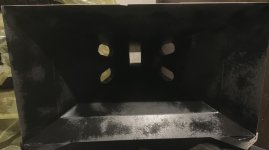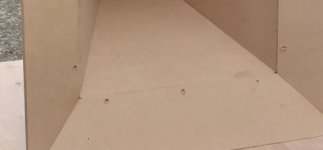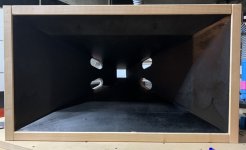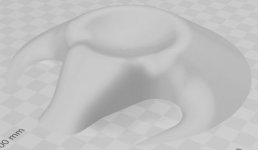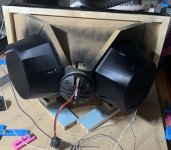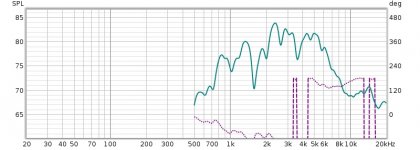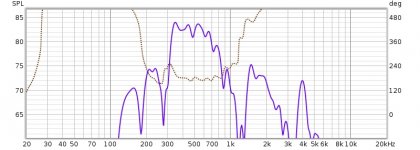I need to try the kreg jig, I bought it a long time ago. And I need a proper table as well. Yesterday when I could not sleep, I thouht about building a special jig for this - similar to the one used for gluing multicell horn cells together. Just a piece of flat wood, a pole with the correct dimension in the middle and strategically placed pieces of wood. In combination with pocket holes it should work.
The best work table i've found is a sheet of 4x8 plywood on 3 saw horses, with a 1 inch 4x8 sheet of foamboard on top of the ply for sacrificial cuts, holes, routings etc
But i use a track saw to make the syn flares...so it might not be as beneficial a setup for you, since you have CNC.
I needed to learn the kreg too, just for the syns. Surprised how easy it was to learn and use....and how well it works,
But i use a track saw to make the syn flares...so it might not be as beneficial a setup for you, since you have CNC.
I needed to learn the kreg too, just for the syns. Surprised how easy it was to learn and use....and how well it works,
I bought a cheap Kreg type jig for my MEH build, also bought genuine Kreg drill bits for it with the countersink built in.
I would not bother for MDF builds, the material is too soft and splits very easily as the screw head tightens into the laminations.
Works ok on plywood.
I just use a small drill bit and start at 90 degrees to the surface, and once the hole has started move the drill to the correct angle and drill the pilot hole.(while the drill is still running) Then run a drill bit through the 1st piece slightly bigger than the screw.
Easier and quicker than using jigs. After glue has set remove screw and fill.
Rob.
Doesn't look as pretty as the Kreg jig but once filled and sanded.....
I would not bother for MDF builds, the material is too soft and splits very easily as the screw head tightens into the laminations.
Works ok on plywood.
I just use a small drill bit and start at 90 degrees to the surface, and once the hole has started move the drill to the correct angle and drill the pilot hole.(while the drill is still running) Then run a drill bit through the 1st piece slightly bigger than the screw.
Easier and quicker than using jigs. After glue has set remove screw and fill.
Rob.
Doesn't look as pretty as the Kreg jig but once filled and sanded.....
Attachments
Last edited:
MDF was just what I had, final product will be plywood. How do you hold the pieces together when drilling? Tape?
MDF was just what I had, final product will be plywood. How do you hold the pieces together when drilling? Tape?
I use a brad nailer to tack the pieces together first, before drilling.
Putting the full primary horn together before drilling for screws.
I also go ahead and screw it together, to check for good drilling, and to know that it will go back together closely as tacked.
After unscrewing, it's easy to break apart for reassemble and glue up, as it only takes 2, maybe 3, brads per joint to put together.
Makes screw and glue much easier, and way more accurate ime.
MDF was just what I had, final product will be plywood. How do you hold the pieces together when drilling? Tape?
Asked my wife to help... usually clamp 1 piece to a work bench then she can hold the 2nd piece in place while I drill..
Rob.
Thank you both! A brad nailer is something that I would have some use for. Or I will use some child labor🙂
I am in the market for one. There are lots of pneumatic ones, but I do not have a compressor. An accumulator based one might be a bit larger and heavier. Decisions, desions.
I stiffened the mouth edges and the driver plate is just glued on (not yet in the picture). There is still a lot of filling and sanding left. I got some "stone effect" spray, which should create some texture to hide imperfections.
I stiffened the mouth edges and the driver plate is just glued on (not yet in the picture). There is still a lot of filling and sanding left. I got some "stone effect" spray, which should create some texture to hide imperfections.
Attachments
Am I correct, that the horizontal directivity for 90 degrees and 53 cm width will be controlled down to ca 550 Hz? The fre around the mouth does count to the width or not?
yep....Keeles formula puts it right about there.
I think the frame counts too. After i add secondary flares i always hear a bit lower control.
Must say though, just like baffle "step", which really should be baffle "ramp", i think pattern control is a ramp too.
Oh, a pancake or small construction site compressor, has worked fine for my run of the mill Hitachi brad nailer...they don't use much air at all.
I think the frame counts too. After i add secondary flares i always hear a bit lower control.
Must say though, just like baffle "step", which really should be baffle "ramp", i think pattern control is a ramp too.
Oh, a pancake or small construction site compressor, has worked fine for my run of the mill Hitachi brad nailer...they don't use much air at all.
Mark, do you have any model recommended? So I would choose based on its specs. I have really no idea what size it should be.
The horn is now ready for its "stone effect" finish, it will actually look quite good. Now I need to print two volume fillers, the old ones were a fail due to printer error. They remind me a Klingon war ship🙂
The horn is now ready for its "stone effect" finish, it will actually look quite good. Now I need to print two volume fillers, the old ones were a fail due to printer error. They remind me a Klingon war ship🙂
Attachments
hi pelanj,
here in the US, i use 18 gauge brad nails (and get a bunch of different lengths cause they are cheap) Not sure how they spec nails elsewhere...
I think any of the compressor/ nailer combos are probably fine....like on this amazon page.
Bostich, Senco, Makita, Dewalt, Porter Cable, all are no doubt OK, and at least as good as the Hitachi 2" brad nailer and a 3 gallon no name compressor i'm using.
I guess most important spec for nailer is brad gauge and length (i can't see ever using anything over 2")
And for compressor, I'd say 100psi or a little better.
Keeping the nailer small is important imo, for getting into more tight places. It's why i wouldn't consider a battery one...battery adds too much size.
I'd probably buy Makita or Senco combo if shopping new...but really, doesn't matter much i think.
here in the US, i use 18 gauge brad nails (and get a bunch of different lengths cause they are cheap) Not sure how they spec nails elsewhere...
I think any of the compressor/ nailer combos are probably fine....like on this amazon page.
Bostich, Senco, Makita, Dewalt, Porter Cable, all are no doubt OK, and at least as good as the Hitachi 2" brad nailer and a 3 gallon no name compressor i'm using.
I guess most important spec for nailer is brad gauge and length (i can't see ever using anything over 2")
And for compressor, I'd say 100psi or a little better.
Keeping the nailer small is important imo, for getting into more tight places. It's why i wouldn't consider a battery one...battery adds too much size.
I'd probably buy Makita or Senco combo if shopping new...but really, doesn't matter much i think.
That would translate to 1.2 mm diameter 50 mm long nails and a 12 l / 8 bar compressor. Makita makes a nice model for up to 55 mm nails and is not too expensive.
Some first measurements. Not really happy about the result. The 8PE21s do not play high enough (or the DE500 low enough). I think this could work with some EQ. The only part I am really happy with is the 300 Hz low end cutoff. Or is this raw response better than I think?
The DE500 is 8 ohms, 8PE21s are 8 ohms in parallel, 4 ohms total.
I think the next one will use four 4" midranges instead and ports closer to the throat. I need to match this to Hornresp simulation to learn from it.
The DE500 is 8 ohms, 8PE21s are 8 ohms in parallel, 4 ohms total.
I think the next one will use four 4" midranges instead and ports closer to the throat. I need to match this to Hornresp simulation to learn from it.
Attachments
Last edited:
I'm wondering what the notches in the 8PE21's response below 300Hz are about.
I'd have thought there would be a much smoother low end rolloff just looking at the factory curve.
How far are your ports from the throat? Just guessing, it looks like about 4 inches to center.
Which would make 1/4 wave notch fairly close to the measurement..... yes? no?
The DE500 looks maybe OK overall, other than the two major notches at 1.6k and 3.6k.
I'd be surprised if it went lower than 800Hz (like shown in meas)
How were the measurements made..... Exactly on-ax, or off-ax slightly?
I'd suggest 10-15 degrees off as a reference axis....
Yep, four 4" (or 5") mid ranges might work better for a "runt type" build, i think.
I'd have thought there would be a much smoother low end rolloff just looking at the factory curve.
How far are your ports from the throat? Just guessing, it looks like about 4 inches to center.
Which would make 1/4 wave notch fairly close to the measurement..... yes? no?
The DE500 looks maybe OK overall, other than the two major notches at 1.6k and 3.6k.
I'd be surprised if it went lower than 800Hz (like shown in meas)
How were the measurements made..... Exactly on-ax, or off-ax slightly?
I'd suggest 10-15 degrees off as a reference axis....
Yep, four 4" (or 5") mid ranges might work better for a "runt type" build, i think.
The notches down there are from FDW filtering. Also, the back covers have really minimal volume, this was intentional. In a proper box, they would do lower.
DE500 notches are most probably room surrounding influence, it was first night time low level measurements. It can do 800 Hz on an exponential-spiral horn at home levels. I will try some measurements in a better space and at more angles. I played further with the measurements - a crossover will be definitely possible and in the end it should be quite good.
I think the ports are closer, more like 3", but I will double check at home.
DE500 notches are most probably room surrounding influence, it was first night time low level measurements. It can do 800 Hz on an exponential-spiral horn at home levels. I will try some measurements in a better space and at more angles. I played further with the measurements - a crossover will be definitely possible and in the end it should be quite good.
I think the ports are closer, more like 3", but I will double check at home.
- Home
- Loudspeakers
- Multi-Way
- 2 way Synergy inspired by SPL Runt
